This time a somewhat longer story about a beautiful bird: the Montagu’s harrier (Circus pygargus). Towards the end of the last century this species was not doing too well. Between 1900 and 1950 there were approximately 500-1000 breeding pairs of this graceful bird of prey in the Netherlands annually. It was originally a bird of open landscapes such as moorland, river flood plains, wet meadows and sand dunes. Because these types of areas, of course by the hand of humans, became smaller and smaller, it quickly went downhill with this species. At the end of the 1980s, the bird had almost completely disappeared from the Netherlands and ornithologists had already written off the bird as a breeding bird. In 1990 ornithologist and nature conservationist Ben Koks, more or less by chance, found a nest in a field with lucerne in the Carel Coenraadpolder. That’s in the east of Groningen, near the Dollard salt marshes in the north of the Netherlands. Three eggs were present in that nest. Through cooperation between a few bird watchers, farmers and a green feed drying company (which would harvest the lucerne), this nest could be protected. And in August 1990 three young Montagu’s harriers fledged. From that year onwards the number of nests in this region increased. On one hand as a result of the large-scale set-aside of agricultural land as part of the so-called MacSharry scheme of the European Union. On the other hand through the continuous commitment of the aforementioned parties.
New habitat
It is remarkable that, due to the lack of its original habitat, the Montagu’s harrier has found a new living environment in the agricultural farmlands, especially cereal crops as barley, wheat, but also with lucerne and rapeseed. This shift of biotope is not only visible in the Netherlands, but has been observed throughout Europe since 1980. The protection of the Montagu’s harrier in Groningen paid off, because even after the area of land being set-aside decreased, the number of breeding pairs continued to increase. In 2000 there were 31 breeding pairs in Groningen, in addition to 14 elsewhere in the country. Nevertheless, the bird is still on the Dutch Red List as seriously endangered. The breeding success is highly dependent on nest protection. After all, in the original biotopes the birds could breed quietly without being disturbed. That is a lot more difficult in the agricultural fields. If a nest in a barley field is not discovered in time, the chances are that the youngsters will be lost when harvesting the barley from mid-July before the harrier chicks have fledged.
Montagu’s Harrier Foundation
The protection of the very first nest of Montagu’s harriers in 1990 resulted in increasing attention for the conservation of this species. Years of – sometimes difficult – conversations with farmers, governments and other stakeholders followed. Gradually the protection received increasing acclaim, not least because of the breeding results. Every year the number of successful hatches increased due to the nest protection. As a result, most farmers are proud when a harrier couple has chosen their field as their nesting site. In 2005, this approach was further professionalized and Ben Koks established the Dutch Montagu’s Harrier Foundation. In the past years the foundation has grown with a few paid employees and many, many volunteers. Scientific researchers are also associated with the working group and there are contacts with universities in the Netherlands and abroad.
Nest protection
The protection work consists of observing grain fields for harriers, for which those 150 volunteers are desperately needed. In the provinces of Groningen, Friesland and Flevoland more than 150 volunteers scour the fields for harriers and I’m one of them. If a male and female harrier show up at such a field very regularly, it is a sign that there may be a nest. If they also land on a spot in the grain, there is already more certainty. Hardly any material is supplied to dress the nest, in contrast to the marsh harrier (Circus aeruginosus). The female of the Montagu’s harrier keeps the nest simple; she flattens some grain stalks and lays her eggs on them. If the location of the nest has been determined and the farmer agrees, a metal mesh protective cage is placed around the nest. The reason for this is in particular to prevent predation by fox (Vulpes vulpes) and stone marten (Martes foina) for instance. As long as the young can’t fly, they form an easy prey for these predators. The cage therefore has edges that are folded outwards, so that it is not possible for a fox or marten to jump or climb over it.
Wingtags and data loggers
Over the years, a number of Montagu’s harriers in the Netherlands, but also beyond, have been provided with means to track the birds. In the past, birds have been equipped with so-called wing tags, plastic flaps that are slid around the wings. This doesn’t bother the birds in their normal life. Because of the format, these colored flaps can be read well from a distance, so that the bird can be identified. There are also birds equipped with so-called data loggers. These are small devices that are attached to the back and that collect information about, among other things, location, altitude, temperature, time. These data can only be read out with an antenna, so the computer to receive the data must be in the direct neighborhood of the bird.
Autumnwatch
Satellite transmitters are the most modern technology used. This allows data to be received at any time of the day. In autumn and spring, for example, the birds can be followed during their migration to Africa and back. There are now more than 64 Montagu’s harriers with a satellite transmitter. The British popular TV program Autumnwatch also paid attention to these birds. In Britain, the Montagu’s harrier is a rare breeding bird, in 2017 there were five pairs located: four were successful and produced a total of 12 fledged youngsters. In addition, a female Montagu’s harrier Sally was provided with a satellite transmitter by Raymond Klaassen from the Dutch Montagu’s Harrier Foundation in 2016. It also received a leg ring with the initials CP, after Chris Packham, one of the presenters of this popular program. And after that the bird was released by co-presenter Martin Hughes Games. Unfortunately, Sally did not last long; in August 2017 the bird vanished near the Sandringham Estate, a country retreat of the British royal family.
Y7
In 2018 there was a nest of a Montagu’s harrier close to my home. There was only one youngster in it and on July 14 this young was big enough to be ringed. Together with Almut Schlaich, researcher and employee of the Foundation, and the farmer with his wife, we walked through the crop to the nest. Almut carefully removed the young from the nest and it was weighed and measured. It was a male with a weight of 320 grams. An adult male weighs around a maximum of 280 grams, so it was a strong youngster. Based on the length of the flight feathers and other characteristics, Almut was able to determine that it was approximately 25 days old. It was in good shape and the down feathers were largely gone. It then received two rings around its legs: a metal ring from the Dutch Bird Ringing Authority in Arnhem and a yellow plastic ring with a black inscription Y7. With a good telescope or telephoto lens, the last ring can be read from some distance. At one of the photos the proud farmer and his wife with this little man. And of course I couldn’t lag behind; such a great experience for me.
Court flight and prey transfer
In 2019, at a short distance from the 2018 nest, no less than two couples of Montagu’s harriers were breeding, about 600 meters apart. One in a barley field and one in the wheat. We found out on May 22 and in the following weeks I started posting one or more hours at least once every two days. This resulted in great moments, including many court flights and prey transfers. At the court flight the male comes flying with a prey and calls the female. If the female also flies up, the male lures her to a quiet place where he lays the prey on the ground. When the female goes into the advances, it flies to that spot to receive the prey and possibly also a copulation takes place. The male then goes hunting or sitting on a pole again. Once the female is on the nest, breeding or taking care of the youngsters, the male takes care of the supply of prey. And that is also spectacular to see. The male also comes flying with a prey in its claws and calls the female, which flies up from the nest towards the male. Then the female will fly under the male and she turns upside down while flying. The male releases the prey and the female catches it and flies to the nest to feed it to her offspring.
Not always a positive outcome …
In both nests we found there were four eggs and after a while they all hatched. By chance we also found another nest in the barley field of a marsh harrier. There were also four eggs in it. The farmer cooperated fully and he kept a sufficient distance from the nests when harvesting, so the birds were disturbed as little as possible. Especially when harvesting the wheat, we had to take extra measures to prevent the nest and the youngsters from getting covered in dust. In spite of all the care when harvesting, it was probably too much disruption for the marsh harrier, because after a while the female left the nest and the eggs didn’t hatch. But our observation of the Montagu’s harriers continued. And then the moment came to ring the youngsters. That takes place when the young birds are 25-28 days old. First the ones in the barley, because that couple had started breeding earlier. On our way to the nest we didn’t see a harrier in the area, but it was stranger that no female flew up from the nest when we approached it. The reason became clear fairly quickly: the nest was empty. There were only a few feathers, still in the feather follicle. The follicle is similar to our hair follicles, the feather develops in it. What caused this? The cage with the bent upper edges is intended to prevent predation by ground predators. Perhaps the predator came from the sky: a buzzard (Buteo buteo) that spotted some easy prey or perhaps a marsh harrier that didn’t turn up its nose for some fresh food. Of course, our disappointment was great.
Even more disappointment
A few weeks later it was time to ring the youngsters in the second nest. A few days before I went to check the nest, because something strange seemed to be happening. In the days before some other volunteers had seen the female with a prey that it had caught herself, but didn’t take it to the nest. The bird had eaten the prey elsewhere, a bad sign. After all, the female takes care of its youngsters first and after that of herself. When I walked to the nest there was no harrier in the neighborhood either, but in the morning I had seen the male sitting on a pole on the edge of the plot. No bird flying up when I approached the nest, history seemed to repeat itself. And no matter how I looked in the cage, no more youngsters. I walked around the cage three times, pushed the grain aside to see if they had not hidden themselves and I overlooked them. But unfortunately. Just as with the other nest, only a few feathers were the silent witnesses.
Not just success stories
So you see, they are not always success stories. Of course it happens more often that nests don’t reach the end. They are predated or the parent birds leave the nest. Every year it happens and that makes sense, that’s how nature works. But two litters, so close together, both ended in the same way. And what would have been the cause? At the last nest I meticulously studied the folded edge of the cage for possible hairs that would indicate a fox or marten. Nothing to see. However, the feathers seemed bitten off, characteristic of a fox. After all, a bird of prey picks its prey, so than the feather tips are still intact. Or would it perhaps have involved a human? We will never know.
Protection remains necessary
But what we do know is that the people of the Montagu’s Harrier Foundation and all those many volunteers, not to mention the farmers involved, have again done their utmost this year to protect these beautiful birds. Generally with great success. In 2019 the Foundation was aware of 52 litters, from which 142 young birds successfully fledged.
I have not seen the parent birds of either litters in the days that followed. They had probably already left for the big trip to Africa, since they had no reason to be here anymore.
Goodbye beautiful harriers, see you next year!
This post has been compiled and translated from previous Dutch blogs from August 15th 2018 and August 23rd 2019.



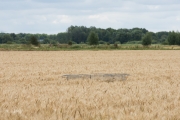
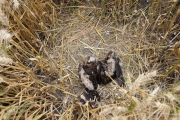
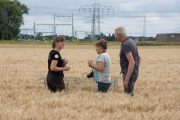
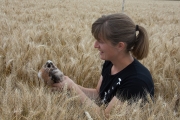
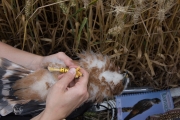
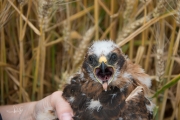
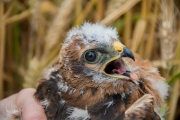
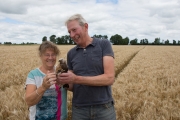
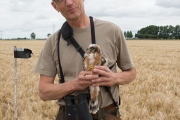
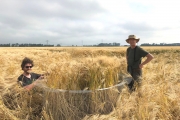
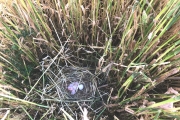
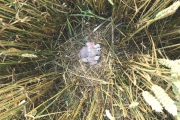
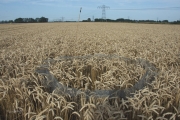
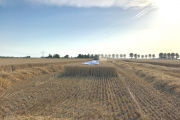
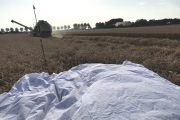
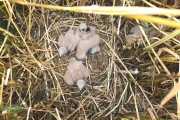
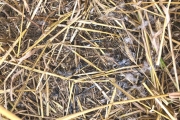
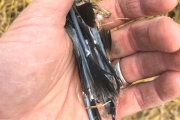
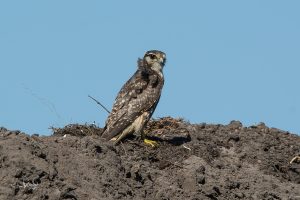
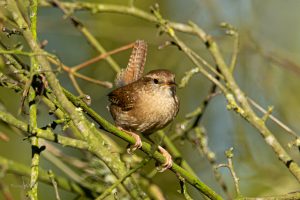
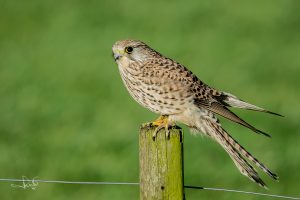
hi like your piece about Montagu’s harriers. I’ll be in Groningen late March for 24 hours only. Is that too early to see them or might they have returned by then? If they may have, is there somewhere easily reached by public transport to go looking?
Hi Ben, Thanks for your compliment. I’m afraid you’re too early for Montagu’s harriers at the end of March. They only arrive in their breeding area here in Groningen at the end of April, the beginning of May. Too bad for you. The areas where they breed are also not really accessible by public transport. It is usually in the middle of the arable area.